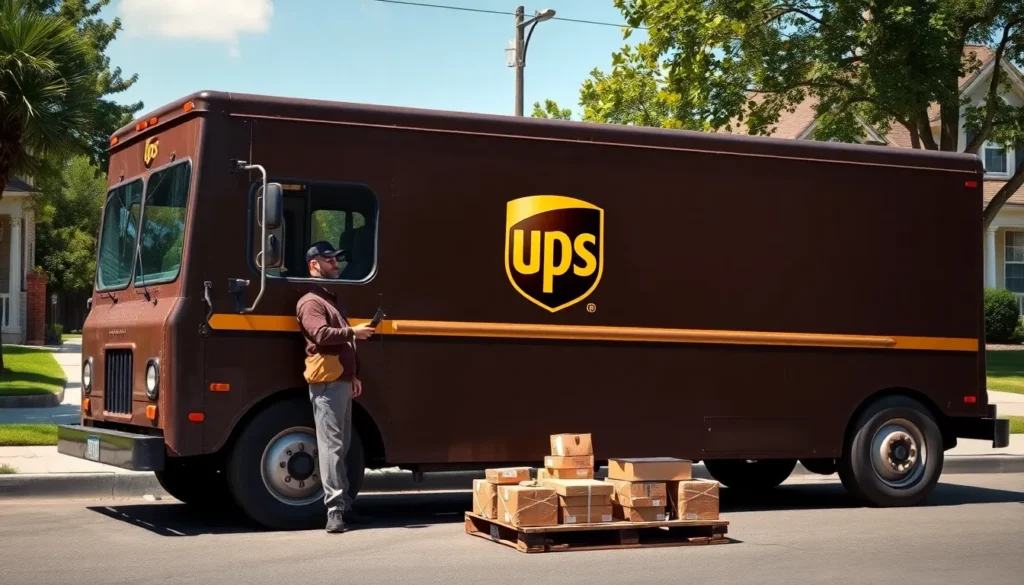Ever wondered when your UPS delivery will finally arrive? If you’ve been anxiously pacing your living room like a contestant on a game show, you’re not alone. Knowing when UPS stops delivering can save you from that nail-biting wait and the awkward dance of checking the tracking app for the hundredth time.
UPS has a reputation for reliability, but their delivery times can feel like a well-kept secret. Spoiler alert: it’s not midnight! Understanding their delivery schedule can help you plan your day better, whether you’re waiting for that new gadget or a surprise gift. So let’s dive into the nitty-gritty of UPS delivery times and put your mind at ease. After all, who wants to be left hanging when that package is just around the corner?
Table of Contents
ToggleOverview of UPS Delivery Times
UPS generally delivers packages from 9 a.m. to 7 p.m. within the local time zone. Service times vary based on location and shipping method chosen. For instance, residential deliveries usually occur later than commercial deliveries, which may end as early as 5 p.m.
Next-day air services often arrive earlier compared to standard ground services. Saturday deliveries are available for certain areas, but not for all service levels. Advanced shipping options might provide delivery by 12 p.m., particularly for urgent shipments.
Tracking UPS shipments offers timely updates for estimated arrival windows. Customers can enter tracking numbers on the UPS website or app for real-time information. Late deliveries can happen, especially during peak seasons such as holidays.
UPS makes a concerted effort to deliver packages on time, but external factors may influence delivery schedules. Weather conditions, high package volumes, and traffic disruptions are among those factors.
UPS also provides the option for package intercepts when a parcel needs redirection before it reaches its final destination. This service is useful for ensuring that packages reach the correct address despite changes in plans. Notably, customers receiving international packages should consider customs processing times, which can affect overall delivery duration.
Factors Affecting Delivery Times

Several factors affect UPS delivery times. Understanding these elements can help recipients better anticipate their package arrivals.
Geographic Location
Geographic location plays a significant role in delivery timing. Urban areas typically receive packages earlier than rural locations due to the density of deliveries. Those living in remote regions may experience longer wait times, as delivery routes take more time to navigate. Areas with fewer UPS facilities also face extended delivery durations. For instance, a package shipped to a major city like New York is likely to arrive faster than one sent to a distant town.
Delivery Type
Delivery type influences when a package arrives. UPS offers different services, such as ground, air, and next-day delivery options. Ground service generally results in slower delivery compared to air options, which often prioritize speed. Residential deliveries usually happen later in the day than commercial shipments. For urgent items, selecting services like UPS Next Day Air ensures a timely arrival, often by noon the following day. Tracking delivery types helps recipients manage their expectations effectively.
Typical UPS Delivery Hours
Understanding UPS delivery hours aids in planning for package arrivals. UPS generally delivers packages from 9 a.m. to 7 p.m. local time, though specific times may differ based on location and service type.
Standard Delivery
Standard delivery typically occurs between 9 a.m. and 7 p.m. in residential areas. Deliveries to commercial locations commonly happen earlier in the day. Packages shipped via ground services can arrive as late as 7 p.m. during peak times. Customers often experience later delivery windows on weekdays compared to weekends. Monitoring tracking information provides updates on delivery status.
Express Delivery
Express delivery offers faster service for urgent packages, with delivery windows differing by service type. For instance, UPS Next Day Air frequently guarantees delivery by noon the following day. Those using UPS 2nd Day Air can expect their items to arrive on the second business day. Express deliveries are not limited to weekdays; some areas receive Saturday deliveries too. Customers should check specific service options when placing their orders to ensure timely arrivals.
What Time Do UPS Stop Delivering?
UPS typically delivers packages until evening hours on weekdays, ending around 7 p.m. local time. This timeframe allows for efficient delivery, ensuring packages reach recipients as scheduled.
Weekdays
On weekdays, delivery usually starts at 9 a.m. and continues until 7 p.m. For residential areas, packages often arrive later in the day. Commercial locations generally receive deliveries earlier than residences, often by the afternoon. Customers should keep in mind that specific delivery windows may vary based on service type, geographic location, and package volume. Those waiting for next-day air or express services can expect earlier arrivals compared to standard ground services. Planning accordingly can help manage expectations regarding arrival times.
Weekends
UPS offers Saturday deliveries in select regions, expanding delivery options for customers. Deliveries on Saturdays typically occur between 9 a.m. and 3 p.m. Shipping services such as UPS Ground and UPS Next Day Air may also have different hours for weekend operations. Saturday delivery isn’t available in all areas, so checking availability when placing an order is recommended. Moreover, recipients should be aware that weekend deliveries can sometimes experience varied traffic conditions, which might impact arrival times.
Tips for Tracking UPS Deliveries
Utilizing UPS’s tracking tools significantly enhances package visibility. Customers can track shipments through the UPS website or mobile app using their tracking number. The tracking feature provides real-time updates, including current package location and estimated delivery time.
Setting up delivery notifications ensures timely updates. Email and SMS alerts notify recipients about package status changes, including when packages are out for delivery and successfully delivered. Notifications help manage expectations and reduce anxiety about arrival times.
Considering UPS My Choice offers added convenience. This service allows customers to customize delivery preferences, such as rescheduling deliveries or authorizing package release without a signature. Members enjoy control over delivery times, improving the overall delivery experience.
Consulting UPS service alerts provides information about unexpected delays. Weather, traffic conditions, and other disturbances can affect delivery schedules. Checking this information aids in understanding potential delays and helps recipients plan accordingly.
Reviewing shipping policies for specific services also enhances tracking efficiency. Each delivery service varies in terms of speed and delivery times. Being aware of these differences ensures recipients select the most appropriate service for urgent needs.
Anticipating peak seasons can assist in managing expectations. During holidays and major events, deliveries often face delays. Understanding these busy periods allows recipients to plan ahead and account for possible disruptions.
Using the UPS access point option presents a flexible delivery solution. Customers can pick up packages at local access points if they’re unavailable for home delivery. This feature adds convenience and offers alternatives when direct delivery isn’t possible.
Understanding UPS delivery times can significantly reduce the anxiety of waiting for packages. With a typical delivery window from 9 a.m. to 7 p.m. local time and variations based on location and service type, it’s essential to stay informed. Utilizing UPS’s tracking tools and setting up notifications ensures recipients remain updated about their shipments. For those in need of urgent deliveries, opting for faster services can make a difference. By considering factors like geographic location and service type, customers can better anticipate their package arrivals. Embracing these strategies can enhance the overall delivery experience and provide peace of mind.



